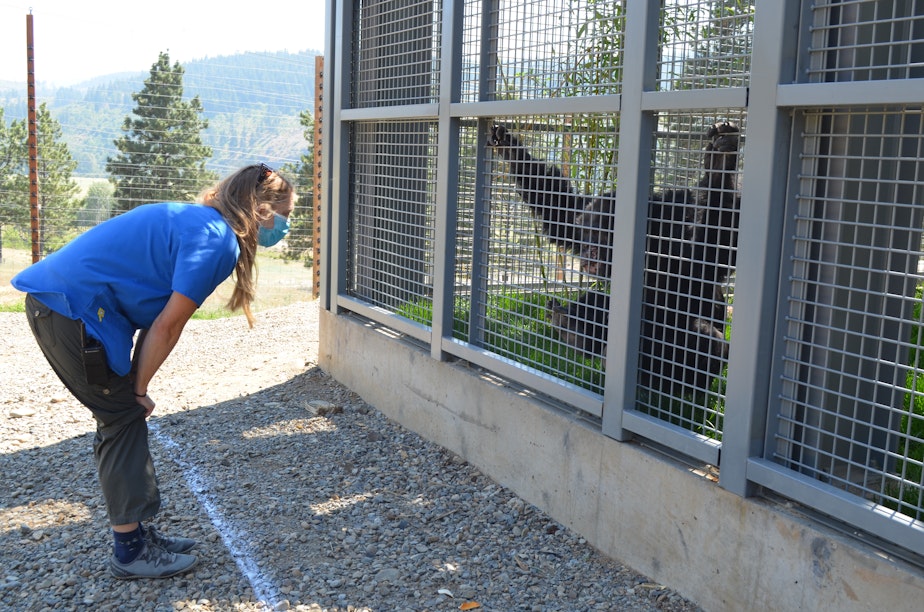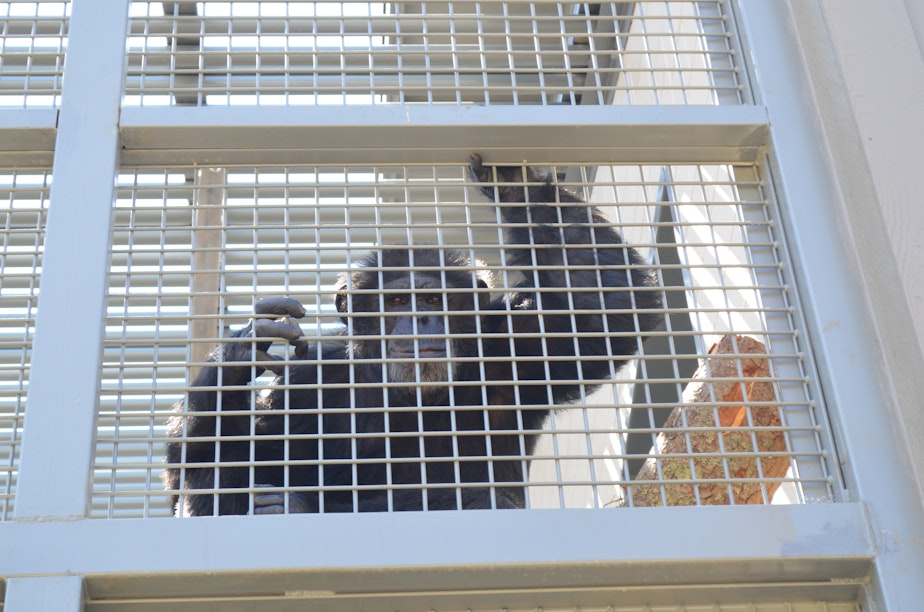Retired lab chimps move to a sanctuary near Seattle — but it's not easy

Gordo's fur stands on end, and he makes a scared chimp sound.
A human he doesn’t recognize is holding a big microphone close to his enclosure. He's nervous.
Chimp Sanctuary Northwest’s co-director Diana Goodrich reassures him.
"It’s okay. You’re fine," Goodrich says. "See — you can come down and say hi."
Gordo, like all the chimpanzees who live at the chimp sanctuary in Cle Elum, about 90 minutes east of Seattle, was once used in biomedical research — including to test hepatitis vaccines. Some of the females here were bred to produce more chimps to be used in research.
The view on chimps had long been, "What are they contributing to humans?" Goodrich said.
That changed in 2015, when the U.S. outlawed using chimpanzees in biomedical research except in very rare circumstances, because the species is endangered. Since then, all government-owned labs, and some that are privately owned, have been trying to transfer the chimps in their care to sanctuaries. But the process is taking longer than anyone envisioned, because building spaces that can house chimps are expensive and complicated, and introducing new chimps into existing social groups is difficult in the best cases, and often impossible.
Sponsored
Researchers who have worked with chimpanzees say they did their best to make sure conditions were humane: They provided space and activities. And, they say, the research made medical breakthroughs on hepatitis vaccines and HIV treatments possible.

But Goodrich said that life in a research lab is "unnatural." For example, in the wild, chimps have one baby every four years or so. But, in labs, they’re not given a chance to breastfeed and raise their young, so they have babies more often.
"Just thinking about all the babies that were taken away from these moms is really sad," Goodrich said.
Goodrich said the aim of Chimp Sanctuary Northwest is to give chimps more autonomy.
Sponsored
"We’re trying to just give them a chance to just figure out who they are, and to be chimpanzees, and to live in a social group with other chimps," she said.
This sanctuary started with a group of seven chimps that arrived in 2008. In 2019, another three arrived.
Goodrich and her team tried to introduce the two groups.
One of the new chimps, Mave, “is super friendly,” Goodrich said. “She was sort of the peacekeeper and gave everyone big hugs when she first met them.”
Yep, chimpanzees hug, just like humans, though less often.
Sponsored

Introducing two different groups of chimps to each other can even potentially be dangerous, but the sanctuary has internal doors that the staff can operate from outside the enclosure, to separate the groups as necessary.
Still, despite the staff’s efforts, the chimpanzees "never really quite calmed down, and there was just a high amount of fighting," Goodrich said.
Now, the three newer arrivals are kept in a separate enclosure.
Each group has their own indoor space, with fake trees to climb and high platforms for the chimps to build nests on and sleep on.
Sponsored
They also have their own outdoor spaces, with room to roam and structures to climb.

Several weeks ago, a new group arrived — six more chimpanzees, Gordo among them. The new group’s alpha is Cy, who’s really into magazines.
"He likes the gossip magazines — looking at pictures of pretty women," Goodrich said.
But, Goodrich added, she doesn’t know the new arrivals fully yet.
Sponsored
"They’re just settling in," she said. "It'll take a few weeks to really know who they are and what they're like and what they want from us."
Right now, the six newest chimps are in quarantine, to make sure they don’t spread any diseases to the chimpanzees already at the sanctuary, but the plan, eventually, is to integrate them with the three chimps that came last year.
Every time the sanctuary adds chimps, it’s expensive: They have to build specialized new structures and extensive electric fencing.
Because it’s so hard to build new space for chimpanzees, hundreds of retired chimps remain in research labs in the US. There’s simply no sanctuary with space for them.
“I'm really glad we were able to take in this group of six,” Goodrich said, “but I am equally excited about all the others getting into good sanctuary homes.”




